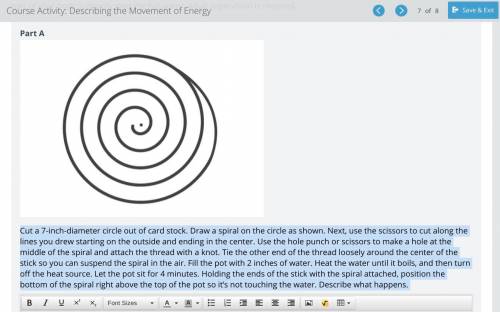
Cut a 7-inch-diameter circle out of card stock. Draw a spiral on the circle as shown. Next, use the scissors to cut along the lines you drew starting on the outside and ending in the center. Use the hole punch or scissors to make a hole at the middle of the spiral and attach the thread with a knot. Tie the other end of the thread loosely around the center of the stick so you can suspend the spiral in the air. Fill the pot with 2 inches of water. Heat the water until it boils, and then turn off the heat source. Let the pot sit for 4 minutes. Holding the ends of the stick with the spiral attached, position the bottom of the spiral right above the top of the pot so it’s not touching the water. Describe what happens.


Answers: 1
Other questions on the subject: Biology


Biology, 22.06.2019 01:40, Skylynn11
An 88 year-old widow with uterine prolapse and multiple comorbid conditions has been unsuccessful in the use of a pessary for treatment elects to receive colpocleisis (lefort type) to prevent further prolapse and avoid more significant surgery like hysterectomy. the treatment is successful. what are the cpt® and icd-10-cm codes reported for this procedure?
Answers: 2

Biology, 22.06.2019 03:30, gaby6951
Rease is an enzyme used by plants to break down urea (a nitrogen-containing compound) into carbon dioxide and ammonia. urease urea > > > carbon dioxide and ammonia ammonia is broken down by plants into a nitrogen source plants need to grow. thus, plants could not use urea as a nitrogen source unless it was first converted to ammonia. in soybean plants there are two different kinds of urease, one produced in the seeds and the other produced in the leaves of the plant. three types of soybean plants were used in a set of experiments: normal soybeans and two mutant strains, one lacking the urease in the seeds only (strain 1) and one lacking urease in the leaves only (strain 2). experiment 1 separate areas in a field were planted with normal, strain 1, and strain 2 soybeans. all types of soybeans appeared to grow, flower, and produce seeds equally well. there were no externally detectable differences among the strains. experiment 2 small pieces of plant leaves of equal weight were obtained from each type of soybean plant and separately placed on media in culture dishes. tissue growing in this way will become an unorganized clump of cells referred to as callus. to provide a controlled nitrogen source, half the tissue samples of each type were placed on media containing urea, and the other half of the samples were placed on media containing ammonia. after 30 days, the weight gain for each of the callus samples was determined. results are shown in the table below.
Answers: 2

Biology, 22.06.2019 05:00, topangabraith
Patient has just received an organ transplant which treatment would be most effective in preventing the patient’s body from
Answers: 2
Do you know the correct answer?
Cut a 7-inch-diameter circle out of card stock. Draw a spiral on the circle as shown. Next, use the...
Questions in other subjects:



Mathematics, 02.02.2022 18:20













